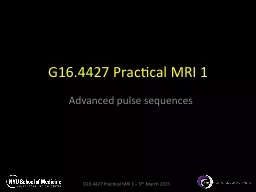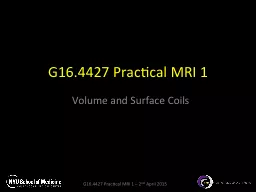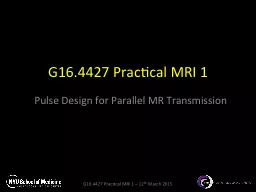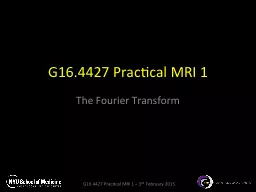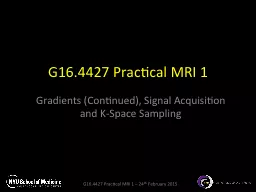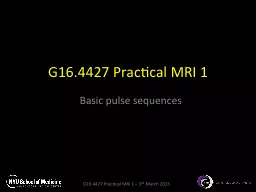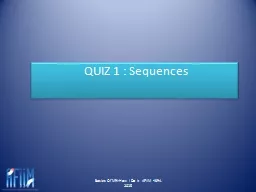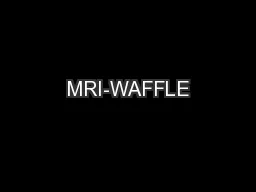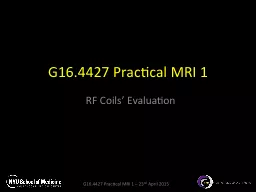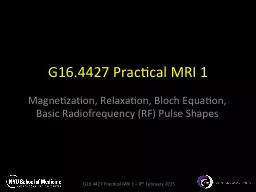PPT-G16.4427 Practical MRI 1
Author : mitsue-stanley | Published Date : 2016-06-30
Advanced pulse sequences Signal Formula for SE M xy negligible TR gtgt T2 or spoiler gradient 90 180 M zA short pulse no T 1 relaxation between A and B or C
Presentation Embed Code
Download Presentation
Download Presentation The PPT/PDF document "G16.4427 Practical MRI 1" is the property of its rightful owner. Permission is granted to download and print the materials on this website for personal, non-commercial use only, and to display it on your personal computer provided you do not modify the materials and that you retain all copyright notices contained in the materials. By downloading content from our website, you accept the terms of this agreement.
G16.4427 Practical MRI 1: Transcript
Advanced pulse sequences Signal Formula for SE M xy negligible TR gtgt T2 or spoiler gradient 90 180 M zA short pulse no T 1 relaxation between A and B or C and D. *Correspondingauthor.Tel.:+33-1-4427-6873;Fax:+33-1-4427-2481;E-mail:cj@ccr.jussieu.frEPSL542619-4-00EarthandPlanetaryScienceLetters178(2000)139^149 www.elsevier.com/locate/epsl perturbation,whichisse Volume and Surface Coils. MR Coils. An MR coil is an inductor capable of producing and/or detecting a time-varying magnetic field. It can be represented as an inductance . L. , with a series resistance . Pulse Design for Parallel MR Transmission. Outline. K-space analysis of small tip-angle excitation. RF shimming and Parallel MR Transmission. B. 1. mapping. Accelerated MR excitations. Homogeneity and SAR minimization. The Fourier Transform. Development of Fourier Analysis. In 1748 Leonhard Euler used linear combinations of “normal modes” to describe the motion of a vibrating string. If the configuration at some point in time is a linear combination of normal modes, so is the configuration at any subsequent time. Gradients (Continued), Signal Acquisition and K-Space Sampling. Spin Echo and Gradient Echo. When the . prephasing. gradient is applied the spins accumulate phase (differently with location). After the 180° pulse, they will continue to accumulate phase under the influence of the readout gradient and will refocus at the echo time.. Basic pulse sequences. Gradient Echo (GRE). A class of pulse sequences that is primarily used for fast scanning. 3D volume imaging. Cardiac imaging. Gradient reversal on the frequency-encoded axis forms the echo. QUIZ 1. :. . Sequences. Basics Of MRI:How I Do It AFIIM -ISRA 2015. QUIZ 1. :. . Sequences. MRI technique . is. . based. on. Ionizing. radiation . imaging. Magnetic. . field. and . ionizing. CHRISTINA SIEBENEICHER. ANIMAL HISTORY-SIGNALMENT. Waffle is a 8 year old spayed female dachshund. Over the past few months waffle has been trouble getting around and yelps in pain when picked up. Waffle can no longer jump onto the couch and doesn’t want to go on her nightly walks anymore. RF Coils’ Evaluation. Outline. Quality factor of an RF coil. Definition of SNR. Determinants of SNR in MRI. Methods to measure SNR in MRI. Ultimate intrinsic SNR. Coil performance maps. Quality Factor. : . Improving. Patient Outcomes. Neil K. Sanghvi, M.D., F.A.C.C.,. F.H.R.S.. Cardiac Electrophysiology. Jacksonville, FL. Office: 904-423-0010. Disclosures. Received honoraria and travel expenses from . Magnet Type. The MRI magnet used at MCH is the superconducting type. Superconducting magnets use a special wire which loses all resistance when cooled to -270 degrees Centigrade. This requires liquid helium to surround the magnet wire. Current is applied to the wire during instillation, which generates the magnetic field as it flows. Superconducting magnets are normally FULLY ENERGIZED at all times.. Magnetization, . Relaxation, Bloch Equation, . Basic Radiofrequency . (RF) Pulse Shapes. Felix Bloch. “ The magnetic moments of nuclei in normal matter will results in a nuclear paramagnetic polarization upon establishment of equilibrium in a constant magnetic field. It is shown that a radio-frequency (RF) field at right angles to the constant field causes a forced precession of the total polarization around the constant field with decreasing latitude as the . Safety Background. The MRI scanner is a very large and powerful magnet. Most clinical scanners are 1.5 - 3 Tesla scanners. 3 Tesla = 30,000 gauss. Earths magnetic field ~ 0.5 gauss. MRI SAFETY. Magnetic Resonance Imaging (MRI) is one of the most powerful medical diagnostic technologies, combining strong magnetic fields with powerful computer image processing.. Douglas Arditti, M.N., M.S.N., FNP, CRNA. Peter Schulman, M.D.. APOM Grand Rounds. January 26, 2015. What is the average delay for the time an MRI is scheduled and the actual time it begins?. How long does it take to start an MRI after induction of anesthesia?.
Download Document
Here is the link to download the presentation.
"G16.4427 Practical MRI 1"The content belongs to its owner. You may download and print it for personal use, without modification, and keep all copyright notices. By downloading, you agree to these terms.
Related Documents

